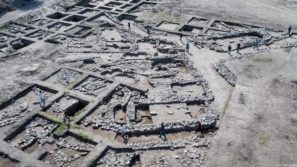
Aerial photograph of the excavation site. Photo courtesy of Assaf Peretz, Israel Antiquities
Authority.
A 5,000-year-old city—considered massive for its timeframe—has been discovered as part of a road construction project in north-central Israel. The city, which could have accommodated around 6,000 inhabitants and was more than a quarter square mile in size, displays ancient city planning, societal hierarchy and more. “This is the Early Bronze Age New York of our region; a cosmopolitan and planned city where thousands of inhabitants lived,” excavation directors on behalf of the Israel Antiquities Authority (IAA) were quoted in an IAA press release as saying.
An “unusual” idolatrous temple was discovered as part of the ancient city, noted the press release, as well as a fortification wall, residential and public areas and streets and alleyways.
“There is no doubt that this site dramatically changes what we know about the character of the period and the beginning of urbanization in Israel,” Itai Elad, Dr. Yitzhak Paz and Dr. Dina Shalem, directors of the excavation on behalf of the IAA, were quoted as saying.
“…This is a huge city—a megalopolis in relation to the Early Bronze Age, where thousands of inhabitants, who made their living from agriculture, lived and traded with different regions and even with different cultures and kingdoms in the area.”
The directors noted that this city reflects a major societal change at that time from a rural community to a “complex society living mostly in urban settings.” The site is considered part of the “first steps” for what was then Canaanite culture to take shape in an urban environment.
Not only does the site imply some type of governing administration to plan the city, but it also shows signs of international trade: Egyptian tools were found there as well.
The location, also once home to another city even older than the five-millennia-year-old megalopolis, had a natural advantage with two springs that allowed for agricultural development.
The IAA press release said flint tools, stone vessels and “millions” of pottery fragments were also found.
As part of the excavation, 5,000 teenagers and volunteers assisted in the archaeological work in the Israel Antiquities Authority’s Sharing Heritage Project. Noah Shaul, a guide on behalf of the IAA, was quoted in the press release as saying, “The challenges the archaeological excavation presented the students, and the uncovering of its findings, contributed both to their personal development and enriched their acquaintance with the country’s landscape, its sites and history.”
Now, those students know a bit more of what it was like to visit the “New York” of the ancient Middle East.
(By Joshua Spurlock, www.themideastupdate.com, October 6, 2019)
